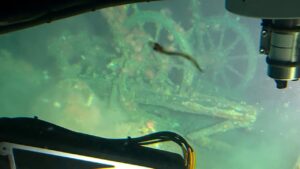You’ve probably heard that we “know more about the surface of Mars than we do about the bottom of the ocean.” That sentiment might be more dramatic than accurate, but the point is well taken — we’re discovering nifty new things about the briny blue all the time.
The latest discovery is a 274-meter deep, 13,660 square-meter blue hole off the coast of the Yucatan Peninsula in Mexico. The underwater cavern is the second deepest of its kind, closely behind a 300-meter-deep blue hole discovered in the South China Sea in 2016.
Researchers discovered the Mexican blue hole — dubbed Taam ja’ — Mayan for “deep water” — in 2021. They published a paper describing their find earlier this year.
The scientists explored Taam ja’ via scuba, sonar equipment, and water sample testing. Using these techniques, they created a map of Taam ja’ along with a chemical profile of its water.

Blue holes provide rich opportunities for exploration of all kinds. Formed by dissolving limestone much like some of the world’s largest cave systems, blue holes normally occur in coastal regions. But despite this proximity to land, blue holes “are largely poorly understood,” coastal geologist Christopher G. Smith told Live Science.
Blue holes: low on oxygen, high on life
The features typically play home to a vast array of marine life, despite being low on oxygen and sporting a unique water chemistry created by dissolving limestone. Those low-oxygen conditions also preserve fossils that would not endure under different circumstances. (If you missed our report on the amateur diver who found improbably preserved ancient brain matter in a low-oxygen sinkhole in Florida, pop over there and check it out after you’re done here.)
A final benefit to studying them? Understanding organisms in a blue hole’s low-oxygen environment could help us better understand how ocean life will adjust to climate change.

A series of photographs showing the geological and biological makeup of Taam ja’. Photos: Alcerreca-Huerta et al/Frontiers in Marine Science
Scouring the scientist’s paper reveals several mentions of “biofilms, sediments, and irregularly shaped rocky ledges,” as well as a variety of worms. Regretfully, there’s no mention of ancient brain matter or ice-age fossils.
While mostly concerned with mapping and chemical makeup, the paper concludes by suggesting further studies on “microbial diversity, hydrogen sulfide measurements, suspended solids, turbidity, photosynthetically active radiation, biological components, and sediment.”
The paper’s authors also suggest that regulatory measures by the government of Mexico might be necessary to prevent the currently pristine Taam ja’ from becoming a compromised tourist attraction.






